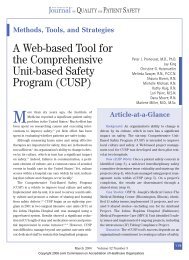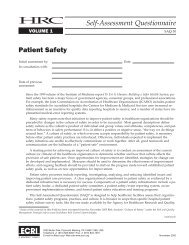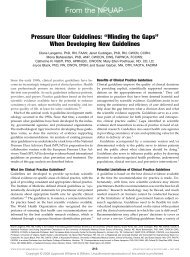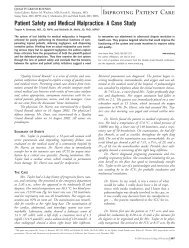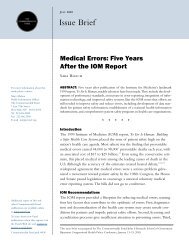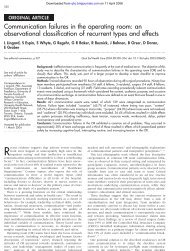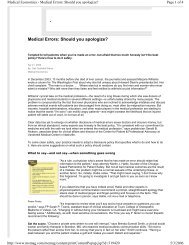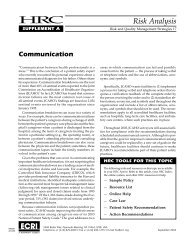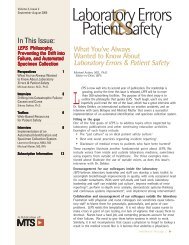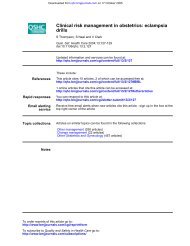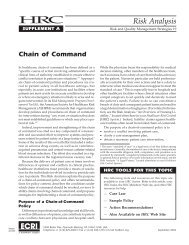Shoulder Dystocia - Lippincott Williams & Wilkins
Shoulder Dystocia - Lippincott Williams & Wilkins
Shoulder Dystocia - Lippincott Williams & Wilkins
You also want an ePaper? Increase the reach of your titles
YUMPU automatically turns print PDFs into web optimized ePapers that Google loves.
<strong>Shoulder</strong> <strong>Dystocia</strong> 19<br />
dystocia. 1,20 <strong>Shoulder</strong> dystocia results from shoulder<br />
bones impacted against the pubic bone or the sacral<br />
promontory, not against soft tissue; therefore, an episiotomy<br />
does not improve outcomes and is not a necessary<br />
component of shoulder dystocia management. 10,23<br />
One nurse should become the scribe and timekeeper<br />
during a shoulder dystocia. Documentation of<br />
the time the shoulder dystocia started, head-to-body<br />
delivery time, and the time other providers, such<br />
as a nursery resuscitation team, arrived should be<br />
noted by the nurse. 10 The Association of Women’s<br />
Health, Obstetric, and Neonatal Nurses (AWHONN)<br />
recommends a narrative summary that shows a “logical<br />
step-by-step approach to relieving the affected<br />
shoulder.” 20(p8) AWHONN cautions that recorded times<br />
must be accurate. 20<br />
A resuscitation area should be ready for the newborn.<br />
Any resuscitation needed and Apgar scores should be<br />
recorded by nursing. An arm that is limp, unmoving,<br />
and extended with absent reflexes indicates brachial<br />
plexus injury. 20 Any bruising of the newborn and limitations<br />
in arm movement should be recorded in the<br />
nurses’ immediate newborn assessment. The nurse<br />
must communicate these findings to the midwife or<br />
physician and the nursing staff receiving the newborn<br />
for postpartum care.<br />
Once the newborn and mother are settled and<br />
starting postpartum recovery, nurses should complete<br />
documentation and review it for consistency with the<br />
documentation of other providers. If, for example,<br />
the provider’s note says there was no episiotomy<br />
but a second-degree laceration and the nurses’ labor<br />
summary says there was an episiotomy, the documentation<br />
must be reconciled for accuracy. Electronic fetal<br />
monitoring time and comment recordings are another<br />
potential source of discrepancy with the medical<br />
record. 20<br />
POSTPARTUM CARE<br />
In the past, physicians, midwives, and nurses avoided<br />
discussing the shoulder dystocia event or prognosis<br />
for fear of receiving blame for mismanagement and increasing<br />
the risk of a negligence claim. Immediate dialogue<br />
following the shoulder dystocia can maximize<br />
effective communication, which can minimize anger<br />
and frustration for the mother and family. 24,25 Debriefing<br />
offers the opportunity to explain the event to the<br />
mother who may not remember or understand what<br />
occurred. Vandekkieft 26 uses an ABCDE (Advance,<br />
Build, Communicate, Deal, Encourage) approach that<br />
includes Advance preparation (know relevant clinical<br />
information). Build a therapeutic environment by determining<br />
what the patient wants and needs to know<br />
and discuss with supportive family members present.<br />
Communicate effectively by being frank but compassionate<br />
and avoiding medical jargon. The nurse further<br />
deals with patient and family reactions allowing time<br />
for tears, anger, and silence and by encouraging and<br />
validating emotions.<br />
The pediatric staff should discuss medical follow-up<br />
with the family so they can anticipate home physical<br />
therapy and additional physician visits. Mothers who<br />
have had a shoulder dystocia need to be informed that<br />
the risk of shoulder dystocia in subsequent pregnancies<br />
is increased. 19 Nursing staff may link mothers with social<br />
or chaplaincy services for extra support. 27<br />
Following a shoulder dystocia with brachial plexus<br />
injury, the nursing staff should contact the organizational<br />
risk manager. The risk manager will assist the<br />
staff with documentation and communication between<br />
providers, the mother, and family. The risk manager can<br />
lead a review of the dystocia management. The purpose<br />
of the case review is not to assign blame but to determine<br />
what measures were successful and what steps<br />
might be refined or changed. The case review should<br />
be attended by anyone present at the birth. This increases<br />
information about the event and potential improvements<br />
to shoulder dystocia management.<br />
The risk for postpartum hemorrhage increases following<br />
a shoulder dystocia. 1 The fundus should be<br />
palpated to assess uterine contraction at least every<br />
15 minutes during the first postpartum hour. Early<br />
newborn breast-feeding increases endogenous maternal<br />
oxytocin to decrease postpartum bleeding. In the<br />
absence of breast-feeding, vigilant assessment and documentation<br />
of maternal blood loss with exogenous<br />
pitocin use can limit maternal blood loss. Perineal<br />
trauma such as bruising and lacerations is common following<br />
a shoulder dystocia. Ice packs applied to the<br />
perineum immediately postpartum reduce edema and<br />
perineal pain. After 24 hours, pain relief may be more<br />
effective using warm sitz baths.<br />
The newborn with a fractured clavicle or humerus<br />
may wear a cloth sling to splint the injured arm. Recovery<br />
is spontaneous. Approximately 80% of brachial<br />
plexus injuries heal over 3 to 6 months postpartum. 7,8<br />
Newborns who lack spontaneous arm movement or<br />
show no improvement in 4 to 6 weeks postpartum<br />
should be referred to pediatric neurologists for<br />
evaluation. 8 Demonstrating any special arm care and<br />
assessing parental comfort with that care are essential<br />
components of newborn discharge planning. Parents<br />
need to understand any newborn referrals and be able<br />
to schedule the appointments.



